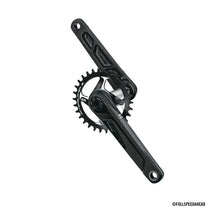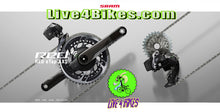Unleash Your Inner Trailblazer with the FSA Afterburner MEGAEXO Modular Crankset 1X
In the world of mountain biking, where performance and precision are paramount, your choice of components can make all the difference. The FSA AFTERBURNER MEGAEXO MODULAR CRANKSET 1X is an epitome of cutting-edge technology and design.
Cracking the Code: FSA AFTERBURNER MEGAEXO MODULAR CRANKSET 1X Specifications:
-
Type - Cranksets: Designed for the most demanding mountain biking trails, the FSA AFTERBURNER MEGAEXO MODULAR CRANKSET 1X is built to withstand the rigors of off-road adventures.
-
Technology - A Masterpiece of Engineering:
- DirectMount: The DirectMount technology simplifies chainring installation, offering a secure and efficient connection.
- Hollow Forged: The crank arms are hollow forged from AL7050 alloy, optimizing strength-to-weight ratio for peak performance.
- MegaExo: The MegaExo technology ensures a robust and durable bottom bracket interface.
- Megatooth: Megatooth design is all about increasing chain engagement for a reliable and smooth ride.
- Modular: The modular design of this crankset allows for different chainring and chainline configurations, adapting to various terrain and riding styles.
-
Discipline - MTB: The FSA AFTERBURNER crankset is purpose-built for mountain biking, making it your trusted companion on challenging trails.
-
Series - AFTERBURNER: Part of the AFTERBURNER series, this crankset is a testament to FSA's commitment to top-tier MTB components.
-
Color - Neutral: The neutral color allows the FSA AFTERBURNER crankset to seamlessly complement the aesthetics of any mountain bike.
-
Weight (grams) - Feather-Light Performance: At just 695 grams, this crankset keeps your bike lightweight, ensuring agile handling on the trails.
-
Bolt Circle Diameter (BCD) - DIRECT MOUNT: The direct mount BCD simplifies chainring attachment, ensuring a secure and hassle-free setup.
-
Crankset Type - Single: Designed for a single chainring, the FSA AFTERBURNER is perfect for riders who prefer a simplified drivetrain.
-
Drivetrain Compatibility - Wide Range: This crankset is compatible with both Shimano 10/11-speed and SRAM 10/11-speed systems, offering versatility for various drivetrain configurations.
-
Material - Alloy: The use of AL7050 alloy in the crank arms ensures a perfect balance between strength and weight, guaranteeing durability in demanding conditions.
-
Convertible Spider Design: The innovative spider design allows for different chainring and chainline configurations, offering riders adaptability and customization.
-
Thick-Thin Tooth Design: The thick-thin tooth profile on the chainring ensures maximum chain engagement, reducing the risk of chain drops.
-
Hollow Forged AL7050 Crank Arms: Hollow forging of the crank arms optimizes their strength-to-weight ratio, delivering exceptional performance.
-
30mm Alloy Spindle: The 30mm alloy spindle provides rigidity and durability to handle the toughest trails.
-
Direct Mount Forged and CNC Machined AL7075 Chainring: The chainring is crafted with precision, ensuring a robust and reliable connection.
-
Optimized for 11-12 Speed Systems: The FSA AFTERBURNER crankset is fine-tuned to work seamlessly with new 11-12-speed drivetrain systems, ensuring optimal performance and shifting efficiency.
Why Purchase from Live4Bikes:
-
Quality Assurance: Live4Bikes is committed to delivering high-quality products, and the FSA AFTERBURNER MEGAEXO MODULAR CRANKSET 1X is no exception. It's been carefully curated to meet the demands of serious mountain bikers.
-
Wide Selection: Live4Bikes offers a broad range of mountain biking components and accessories, ensuring you can find the perfect components to meet your specific needs and riding style.
-
Expert Support: The Live4Bikes team comprises passionate cyclists and outdoor enthusiasts who can provide expert guidance. Whether you're an experienced rider or a newcomer, their knowledge and assistance will help you make informed choices.
-
Exceptional Customer Service: Live4Bikes is dedicated to providing outstanding customer service. Your purchase experience will be smooth, and they are always ready to address any questions or concerns you may have.
In conclusion, the FSA AFTERBURNER MEGAEXO MODULAR CRANKSET 1X is a high-performance, precision-engineered component for avid mountain bikers. When you choose to purchase this crankset from Live4Bikes, you're not just getting a top-tier product, but you're also benefiting from their dedication to customer satisfaction, expertise, and a comprehensive range of mountain biking accessories. Enhance your trail-blazing adventures and power your ride with the FSA AFTERBURNER from Live4Bikes.
 |

|
 |
 |
- More Crank info
- DIY TIPS
- Minimize Windows
Understanding Bicycle Cranks: Types, Sizes, and Materials
Introduction
Bicycle cranks are a crucial component of a bike's drivetrain, responsible for transferring the rider's pedaling force to the chainring, which in turn propels the bicycle forward. In this article, we'll explore the various types of bicycle cranks, different sizes available, and the materials they are constructed from.
Types of Bicycle Cranks
-
Square Taper Cranks:
Square taper cranks are a traditional design, characterized by a square-shaped spindle that fits into the bottom bracket. They have been a standard for many years, known for their simplicity and durability. However, they are becoming less common with the rise of newer technologies.
-
Octalink Cranks:
Shimano introduced the Octalink system, which features eight splines on the crank arm that interface with a matching bottom bracket. Octalink cranks are known for their increased stiffness and power transfer compared to square taper cranks.
-
ISIS Drive Cranks:
ISIS (International Splined Interface Standard) drive cranks use a splined interface between the crank arm and the bottom bracket spindle. This design was intended to improve stiffness and durability, but it has been largely replaced by newer standards.
-
External Bearing Cranks:
External bearing cranks, also known as Hollowtech II (by Shimano) or GXP (by SRAM), use outboard bearings that sit outside of the bottom bracket shell. This design provides increased stiffness and weight savings.
-
Direct Mount Cranks:
Direct mount cranks have become popular in recent years, especially in the mountain biking community. They attach directly to the spindle, eliminating the need for a separate chainring spider. This design allows for a wider range of chainring sizes and improved stiffness.
Different Sizes of Bicycle Cranks
-
Crank Arm Length:
Crank arm length is measured from the center of the bottom bracket spindle to the center of the pedal spindle. Common lengths range from 165mm to 180mm. Shorter crank arms can provide a more aerodynamic position and are favored by some cyclists, while longer crank arms may offer more leverage for powerful pedaling.
-
Chainring Sizes:
The size of the chainring(s) on the crankset can significantly affect the bike's gearing. Smaller chainrings provide easier pedaling but lower top speeds, while larger chainrings offer higher top speeds but require more effort to pedal.
Materials Used in Bicycle Cranks
-
Aluminum:
Aluminum cranks are lightweight, relatively inexpensive, and offer good stiffness. They are popular in entry-level and mid-range bicycles.
-
Carbon Fiber:
Carbon fiber cranks are known for their exceptional strength-to-weight ratio. They offer excellent stiffness and can help reduce overall weight, making them popular among high-end and performance-oriented cyclists.
-
Steel:
Steel cranks are durable and cost-effective but tend to be heavier than aluminum or carbon fiber options. They are commonly found on budget-friendly and commuter-oriented bikes.
-
Titanium:
Titanium cranks strike a balance between weight, strength, and durability. They are relatively lightweight and offer excellent corrosion resistance, making them a premium choice for some cyclists.
Conclusion
Choosing the right bicycle crank is essential for optimizing your riding experience. Consider factors like the type of riding you'll be doing, your personal preferences, and your budget when selecting a crankset. Understanding the different types, sizes, and materials available will help you make an informed decision that suits your specific cycling needs.
```Comprehensive Guide to Removing a Square Taper Bicycle Crank
Tools Needed:
- Crank puller tool (compatible with square taper cranks)
- Allen wrench or socket wrench set
- Bottom bracket tool (if necessary)
- Grease (optional)
- Rag or cloth (to clean and wipe parts)
Step-by-Step Guide:
-
Prepare Your Workspace:
Start by finding a clean, well-lit area to work. Lay down a rag or cloth to catch any dirt or small parts that may fall.
-
Gather Tools:
Ensure you have all the necessary tools listed above.
-
Prepare the Bike:
If you have a derailleur, shift the chain onto the smallest chainring to provide easier access to the crankset. If you have a single-speed or fixed-gear bike, you don't need to worry about this step.
-
Remove the Crank Bolts:
Use an Allen wrench or socket wrench to loosen and remove the bolts that hold the crank arms onto the bottom bracket spindle. There are usually two bolts, one on each side.
-
Use the Crank Puller:
Insert the inner part of the crank puller tool into the bottom bracket spindle. Make sure it's threaded securely. Then, thread the outer part of the tool into the crank arm threads. Tighten the outer part of the crank puller tool until the crank arm starts to come off the spindle.
-
Remove the Crank Arm:
Continue to turn the crank puller until the crank arm comes off the spindle. Be sure to support the crank arm with your hand as it comes free to avoid it falling and potentially damaging the ground or other components.
-
Repeat for the Other Side:
If you're removing both crank arms, repeat steps 4-6 for the other side.
-
Inspect and Clean:
Take this opportunity to inspect the bottom bracket and crankset for any signs of wear or damage. Clean the spindle and bottom bracket shell if necessary.
-
Reassembly (if needed):
If you're replacing the crankset or performing maintenance, this is the time to install the new one. Apply a thin layer of grease to the square taper interface before attaching the new crank arms.
-
Tighten Everything Securely:
Ensure that all bolts and nuts are properly tightened to the manufacturer's specifications. Over-tightening can cause damage, so use a torque wrench if available.
-
Test the Crankset:
Spin the crankset to ensure there's no wobbling or unusual resistance. Check that the chain moves smoothly across the chainrings.
Remember to always refer to your specific bike's manufacturer recommendations and specifications, as there may be slight variations in the process depending on the make and model. If you're unsure or uncomfortable with any step, consider seeking help from a professional bike mechanic.




